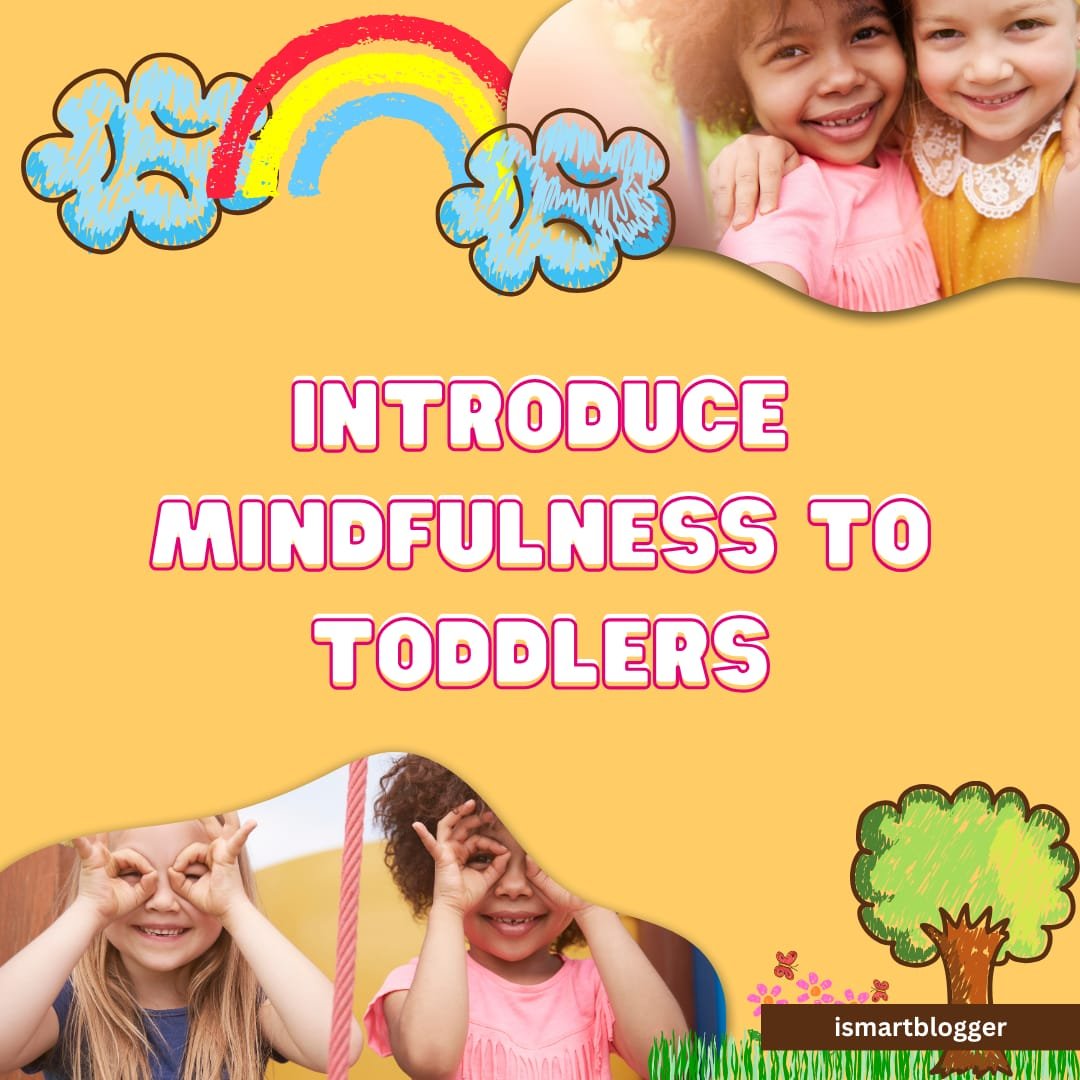Introduction
Mindfulness, a practice rooted in ancient Eastern philosophy, has gained significant popularity in recent years. It involves paying attention to the present moment with non-judgmental awareness, cultivating a sense of calm and clarity.
While it may seem like an abstract concept for toddlers, who are known for their boundless energy and short attention spans, introducing mindfulness to them can have remarkable benefits for their overall well-being. Mindfulness offers toddlers a powerful tool to navigate their rapidly changing world.
With its emphasis on present-moment awareness, mindfulness helps young children develop skills such as self-regulation, emotional resilience, and focus. By teaching toddlers to slow down and tune into their thoughts, emotions, and physical sensations, we provide them with valuable tools that lay the foundation for lifelong emotional intelligence.
A Brief Explanation of Mindfulness
At its core, mindfulness involves being fully present in the moment without judgment or attachment. For toddlers, this means becoming aware of what is happening inside and outside themselves—their thoughts, emotions, bodily sensations—without getting caught up in them.
It is about accepting things as they are without trying to change or control them. When applied to the toddler years specifically, mindfulness can help little ones learn how to navigate challenging emotions like frustration or anger by recognizing these feelings as temporary states rather than overwhelming obstacles.
It helps develop a sense of patience and acceptance while enhancing empathy towards themselves and others. By cultivating these qualities at an early age through mindful practices tailored to their developmental stage, we set the stage for healthier coping mechanisms later in life.
The Importance of Introducing Mindfulness Early
Introducing mindfulness practices during early childhood is crucial due to its impact on brain development during this critical period. The toddler years mark a time when neural connections are rapidly forming, and the brain is highly sensitive to environmental influences.
By incorporating mindfulness into a toddler’s daily routine, we provide them with crucial neural pathways that support emotional regulation and self-awareness. Furthermore, toddlers are naturally receptive and curious learners.
Their sponge-like brains eagerly absorb new information and experiences. By introducing mindfulness at this age, we tap into their innate capacity for growth and learning, setting them on a path towards a more mindful approach to life as they mature.
Starting early also allows for the integration of mindfulness into everyday activities, making it a seamless part of their lives from the beginning. By embracing the potential of mindfulness in early childhood, we open doors to creating emotionally resilient individuals who can navigate life’s challenges with grace and understanding.
Mindfulness offers toddlers an invaluable gift—a way to connect with themselves and the world around them in a profound yet simple manner. In the following sections of this article, we will explore various ways to introduce mindfulness practices tailored specifically for these young explorers, empowering them on their journey towards mindful living.
Understanding Mindfulness for Toddlers
Defining Mindfulness in Simple Terms
When it comes to introducing mindfulness to toddlers, it is essential to define the concept in a simple and age-appropriate manner. Mindfulness can be explained as the practice of paying attention to the present moment without judgment.
For little ones, this means being fully engaged with what they are doing or experiencing at any given time, whether playing, eating or even just taking a walk. It involves being aware of their thoughts, feelings, and sensations without getting caught up in them.
To make it more relatable for toddlers, you can use playful analogies. For instance, you can compare mindfulness to “being like a curious observer,” encouraging them to notice things around them just like little detectives investigating their surroundings.
Another approach could be using familiar characters from stories or cartoons that exhibit mindfulness traits by staying focused and calm amidst different situations. By simplifying the definition of mindfulness and making it relatable through creative storytelling techniques, toddlers will better understand this abstract concept.
Exploring How Toddlers Can Practice Mindfulness
Toddlers have a natural capacity for living in the present moment; however, they often need guidance on how to channel that awareness into intentional practice. One effective way for toddlers to engage in mindfulness is through sensory activities.
These activities involve exploring different senses such as touch, sight, sound, smell, and taste while remaining fully attentive and engaged with each sensation. For example, you can create a sensory bin filled with various textures like soft fabric scraps or smooth pebbles that invite tactile exploration while encouraging them to focus on what they feel.
Additionally, incorporating mindful breathing exercises can help toddlers develop awareness of their breath as an anchor to the present moment. Keep in mind that these exercises should be adapted according to their attention span and abilities.
You can guide them to take deep breaths in and out, emphasizing the sensations of air entering and leaving their bodies. You could also use visual aids like blowing bubbles or balloons to make it more fun and interactive for them.
Furthermore, toddlers can practice mindfulness through simple activities that enhance their focus and concentration. This can involve engaging in puzzles, building blocks, or even coloring.
Encourage them to truly immerse themselves in these activities by paying attention to the details, allowing them to experience a sense of calm and fulfillment in the process. Understanding mindfulness for toddlers requires presenting its definition in simple terms that resonate with their young minds.
By introducing sensory activities, breathing exercises, and focus-enhancing activities into their daily routines, toddlers can begin practicing mindfulness at an early age. These practices lay the foundation for cultivating present-moment awareness while nurturing emotional regulation skills essential for their overall well-being.
Creating a Mindful Environment Designing a calm and peaceful space for toddlers to practice mindfulness:
One of the crucial aspects of introducing mindfulness to toddlers is creating an environment that fosters a sense of calm and tranquility. By designing a dedicated space for mindfulness activities, you can help create a special place where your little ones feel safe and encouraged to explore their inner selves.
This designated area should be free from distractions, allowing toddlers to fully immerse themselves in the present moment. Soft lighting and soothing colors:
When it comes to selecting lighting for your toddler’s mindful space, opt for soft and gentle illumination. Harsh or bright lights can be overwhelming and may hinder their ability to relax.
Consider using warm ambient lighting sources such as table lamps or string lights with dimmers. Additionally, choosing soothing colors like pastels or earth tones can contribute to creating a serene ambiance that promotes relaxation.
Comfortable cushions or mats for sitting or lying down To ensure optimal comfort during mindfulness practice, provide plush cushions or soft mats for toddlers to sit on comfortably.
A variety of options are available, from floor pillows to bean bags, so choose what suits your child’s preferences best. The cushions should be supportive enough without being too firm, allowing them to find their ideal posture while meditating or engaging in other mindful activities.
Likewise, if your toddler prefers lying down during certain exercises like progressive muscle relaxation, providing a cozy mat allows them to fully relax their bodies. Nature-inspired elements like plants or pictures:
Incorporating nature-inspired elements into your toddler’s mindful space can help create a connection between them and the natural world around them. Consider placing potted plants around the room – low-maintenance varieties that are safe for children are readily available – as they not only add beauty but also purify the air by releasing oxygen.
Additionally, displaying pictures of nature scenes such as forests, mountains, or animals can evoke feelings of peace and harmony within your little one. These visual cues can serve as gentle reminders of the beauty and tranquility found in nature, aiding in their mindfulness practice.
By intentionally designing a calm and peaceful space for toddlers to practice mindfulness, you create an environment that supports their exploration and understanding of this valuable practice. Soft lighting and soothing colors contribute to a serene ambiance, while comfortable cushions or mats provide physical comfort during meditation or other mindful activities.
Incorporating nature-inspired elements further enhances the connection between toddlers and the natural world, fostering a sense of peace and harmony. This mindful environment sets the stage for toddlers to develop their attention, emotional regulation, and self-awareness skills as they embark on their mindfulness journey.
Mindful Breathing Exercises for Toddlers
Teaching toddlers to focus on their breath as a way to anchor their attention
Introducing the concept of mindful breathing to toddlers can be a transformative experience in cultivating their ability to anchor their attention and regulate their emotions. Toddlers often have boundless energy and finding ways to help them slow down and center themselves can be challenging. However, by teaching them simple techniques to focus on their breath, we can empower them with a valuable tool for self-awareness and emotional well-being.
To begin, it is important to choose a quiet and comfortable space where your toddler feels relaxed. Sit beside them and guide them through the process of paying attention to their breath.
Use language that is appropriate for their age, explaining how our breath goes in and out like the wind blowing through the trees or a gentle ocean wave. Encourage them to close their eyes if they feel comfortable, but it is not necessary at this stage.
Explaining the concept of inhaling and exhaling with simple language and visuals
When explaining the concept of inhaling and exhaling to toddlers, simplicity is key. Visual aids can be immensely helpful in making these abstract ideas more tangible for young minds. You might demonstrate by placing your hand on your chest or belly while breathing slowly, allowing your toddler to feel the gentle rise and fall with each breath.
Using visual cues such as blowing bubbles or holding feathers can also capture a toddler’s imagination while illustrating the process of inhaling deeply through the nose and exhaling gently through the mouth. Reinforce this understanding by repeating short phrases like “Take a big sniff in…and blow it out like you’re blowing out birthday candles!” The goal is to create an engaging experience that helps toddlers comprehend these fundamental concepts.
Guided breathing exercises tailored to toddler’s attention span
Given toddlers’ naturally short attention spans, it is crucial to tailor guided breathing exercises to their capabilities. These exercises should be brief, interactive, and joyful for them to stay engaged and reap the benefits of mindfulness.
One effective approach is to introduce playful imagery that resonates with their interests and imagination. For example, you may suggest that they imagine smelling a beautiful flower while taking a slow inhale through the nose, then blowing out pretend birthday candles while exhaling softly through the mouth.
Keep the instructions clear and concise, allowing pauses for them to follow along at their own pace. It’s essential to remember that toddlers might not fully grasp the deep philosophical aspects of mindfulness.
Instead, focus on creating a positive association with mindful breathing by making it an enjoyable experience that they can understand and appreciate in their unique way. Over time, these tailored guided breathing exercises will build resilience in toddlers and lay a foundation for their future mindfulness practice.
Sensory Awareness Activities
Engaging the senses to promote mindful awareness in toddlers
Creating a mindful environment for toddlers involves engaging their senses to cultivate mindful awareness. By introducing various sensory activities, we can help children develop a deeper connection with the present moment. One effective way is through exploring different textures using tactile objects such as soft blankets and smooth stones.
Encourage toddlers to touch these objects mindfully, guiding them to focus on the sensations that arise as they run their fingers over the surfaces. This sensory exploration can enhance their ability to stay present and improve their overall sensory awareness.
Listening mindfully to calming sounds
Another powerful method of promoting mindfulness in toddlers is by guiding them to listen mindfully. Calming sounds, such as gentle music or nature sounds, can be introduced during specific mindfulness sessions or incorporated into everyday activities.
Encourage your child to close their eyes and listen closely without judgment or analysis. As they immerse themselves in the soothing melodies, assist them in noticing how each sound unfolds and fades away, helping them cultivate a deep sense of presence and attentiveness.
Noticing scents with scented playdough or essential oils
The sense of smell offers a rich opportunity for toddlers to engage in mindfulness practices. Scented playdough or essential oils provide avenues for sensory exploration while developing an appreciation for present-moment experiences.
Offer your child scented playdough made with natural ingredients like lavender or citrus, inviting them to touch it gently and inhale its fragrance mindfully. Similarly, introducing essential oils with calming scents during relaxation time can create an immersive experience that encourages focused attention on the present moment’s olfactory sensations.
Observing how different smells affect their mood and emotions helps children understand the power of scent in influencing their overall well-being. By incorporating these sensory awareness activities into your toddler’s daily routine, you can foster a deeper sense of mindfulness and presence.
Remember to provide a safe and supervised environment during these activities, ensuring that the materials used are age-appropriate and non-toxic. Through engaging their senses, toddlers will develop a profound connection with the present moment, promoting emotional regulation, focus, and an overall sense of well-being.
Mindful Movement Games and Activities
Introducing mindful movement through fun games and activities
Incorporating mindful movement into the daily routine of toddlers can significantly enhance their overall well-being. By engaging in playful activities that emphasize body awareness and focus, toddlers can develop a deeper connection with their physical selves and cultivate a sense of calmness. Introducing these activities as enjoyable games ensures that toddlers perceive them as exciting rather than tedious tasks, making the learning process more effective and enjoyable.
Yoga poses adapted for toddlers (e.g., tree pose, butterfly pose)
Yoga is an excellent practice for introducing mindfulness to toddlers as it combines movement with focused attention. Adapting yoga poses specifically for young children ensures that they are safe, approachable, and enjoyable.
For instance, the tree pose can be modified by encouraging toddlers to stand tall like a tree while raising one leg gently off the ground. The butterfly pose can involve sitting on the floor with legs bent and soles of the feet together while flapping their ‘wings.’
Engaging in these yoga poses not only promotes physical strength, balance, and flexibility but also teaches toddlers to concentrate on their bodies’ sensations. Encouraging them to breathe deeply while holding each pose helps further instill mindfulness into their practice.
Walking meditation – encouraging slow, deliberate steps while focusing on sensations
Walking meditation is a fantastic way to introduce toddlers to mindfulness in motion. This activity encourages them to take slow, deliberate steps while paying attention to various sensations within their bodies. Begin by explaining the concept of walking mindfully: being fully aware of each step taken.
Guide your toddler by asking them to notice how their feet make contact with the ground—whether it feels soft or hard beneath them—while consciously feeling the weight shift from one foot to another. Encourage them to observe how their legs move, the feeling of air flowing in and out of their nostrils with each breath, and any other sensations they may encounter during the walk.
By engaging in walking meditation, toddlers can learn how to be present in the moment, appreciating each step they take and fostering a sense of mindful awareness in their everyday lives. Overall, incorporating mindful movement games and activities into a toddler’s routine can be an exciting way to introduce them to mindfulness.
Whether through adapted yoga poses or walking meditation, these activities help children develop body awareness and focus while instilling a sense of calmness and presence. By making these experiences enjoyable and interactive, toddlers will acquire valuable tools for nurturing their well-being as they continue to grow and explore the world around them.
Mindfulness Through Art and Creativity
Exploring Artistic Expression as a Form of Mindfulness for Toddlers
Art and creativity provide excellent avenues for toddlers to explore mindfulness. Engaging in art activities encourages them to be present in the moment, focus their attention, and express themselves. Through artistic expression, toddlers can tap into their imagination, enhance their sensory awareness, and cultivate a sense of calm.
Here are some ideas on how to introduce art as a form of mindfulness for toddlers:
1. Sensory Art: Encourage toddlers to experiment with different textures, colors, and materials in their artwork. Provide them with various art supplies such as finger paints, playdough, feathers, or fabric scraps. Let them explore these materials through touch and try not to impose any specific outcome or result. Focus on the process rather than the final product.
2. Mindful Coloring: Introduce mindful coloring activities by providing coloring books or simple mandalas designed for young children. Encourage them to choose colors mindfully, pay attention to the strokes they make with the crayons or markers, and observe how they fill the space with colors.
3. Nature-inspired Crafts: Engage toddlers in nature-inspired crafts that promote mindfulness through connecting with the natural world. Collect leaves or flowers during outdoor walks and create collages or press them onto paper using non-toxic glue sticks. This activity helps toddlers appreciate nature’s beauty while fostering concentration and fine motor skills.
Conclusion
Incorporating art and creativity into mindfulness practice for toddlers can have numerous benefits in their overall development. Through artistic expression, children learn to focus their attention on the present moment while exploring their creative abilities freely without judgment or pressure for perfectionism. Encouraging mindful art activities not only enhances their sensory awareness but also nurtures their emotional well-being.
By providing a nurturing and supportive environment, parents and caregivers can help toddlers develop a sense of calm, self-expression, and the ability to find joy in the process rather than solely focusing on the result. By introducing mindfulness through art and creativity at an early age, we empower toddlers to cultivate lifelong skills that will support their mental, emotional, and cognitive growth. As they grow older, these skills will enable them to navigate life’s challenges with resilience and creativity. Embrace the wonders of artistic expression as a gateway to mindful living for your little ones – a journey that will shape their lives positively for years to come.





